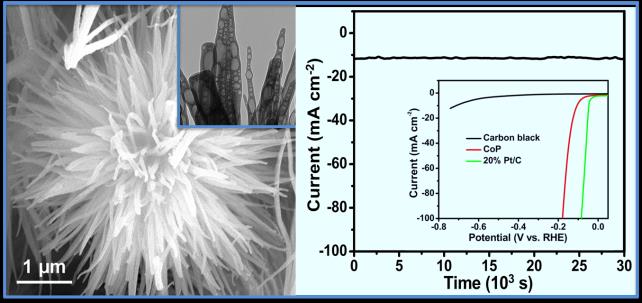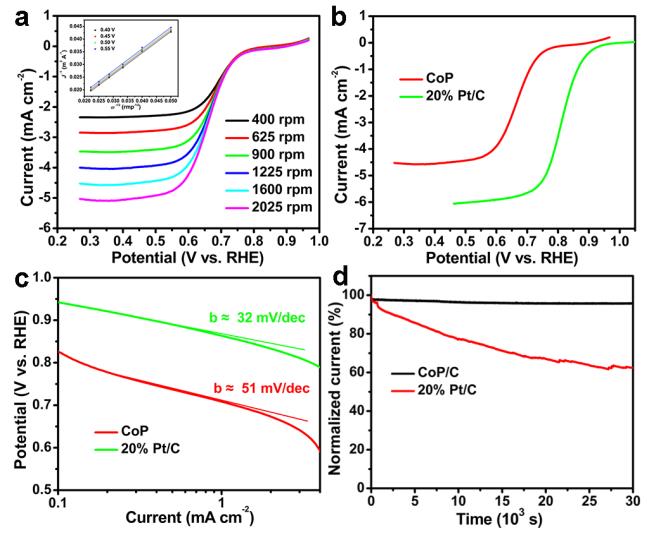Increasing the energy crisis and environmental pollution has motivated intense research on many sustainable alternative energy carrier systems with high efficiency and natural abundance along with environmental benignity. The electrochemical hydrogen evolution reaction (HER) and oxygen reduction reaction (ORR) are the promising energy conversion and storage methods. Therefore, it is fairly necessary to develop high-efficiency HER and ORR electrocatalysts. Pt and its alloys, exhibiting low overpotential, small Tafel slope and good durability, are one kind of the best HER and ORR electrocatalysts, but their high cost and low reserves limit their widespread applications. Consequently, it is urgent to develop effective HER and ORR electrocatalysts with low cost and high abundance.
Recently, the transition metal phosphides were reported to show higher HER activity than other transition-metal-based electrocatalysts. Nevertheless, these electrocatalysts with morphologies of 0-dimensional (0D) NPs and 1-dimensional (1D) NWs are of easy agglomeration under high current density or long-term test during HER and/or ORR, resulting in poor stability, which greatly discount the potential of these electrocatalysts for practical applications. Therefore, it is quite desirable to design high-efficiency non-precious-metal HER and ORR electrocatalysts with superior durability.
Prof. WANG Qiangbin’s group, at Suzhou Institute of Nano-tech and Nano-bionics, Chinese Academy of Sciences prepared a new kind of 3D urchin-like CoP NCs via a facile two-step synthetic strategy. The as-prepared urchin-like CoP NCs exhibit excellent efficiency as HER catalyst with an onset overpotential of ~50 mV vs. RHE, a small Tafel slope of ~46 mV/decade, an exceptional low overpotential of ~180 mV at a current density of 100 mA cm-2 in 0.5 M H2SO4 with mass loading of 0.28 mg/cm2 and remain its catalytic activity for at least 10000 CV cycles in acidic media, which are better than most of other non-noble metal catalysts and approach to a commercial carbon-supported Pt catalyst (20 wt% Pt on Vulcan XC-72, Pt/C) at the same mass loading density of 0.28 mg/cm2 (0.28 mg Pt/C/ cm2). Meanwhile, the urchin-like CoP NCs present remarkable ORR electrocatalysis with a half-potential of 0.7 V and an onset potential of 0.8 V at 1600 rpm and a scan rate of 5 mV s-1 in 0.1 M KOH, along with a superior stability (>30000 s) over commercial Pt/C for ORR.
This work was supported by National Natural Science Foundation of China (No. 21303249, 81401464, 21425103, 21501192), and Natural Science Foundation of Jiangsu Province (BK2012007, SBK201341397).

Figure 1. Porous urchin-like CoP nanocrystals with high hydrogen evolution reaction performance.(Image by WANG Qiangbin's group)

Figure 2. ORR data of the CoP NCs.(Image by WANG Qiangbin's group)
Reference:
Hongchao Yang, Yejun Zhang, Feng Hu, and Qiangbin Wang, Urchin-like CoP Nanocrystals as HER and ORR Dual-Electrocatalyst with Superior Stability, Nano Lett. 2015, 15, 7616 ?7620.
Contact information:Prof.WANG Qiangbin
Suzhou Institute of Nano Tech and Nano Bionics ,Chinese Academy of Science
Suzhou,Jiangsu 215123,China.
E-mail:qbwang2008@sinano.ac.cn
(Information Resource: Suzhou Institute of Nano Tech and Nano Bionics)

